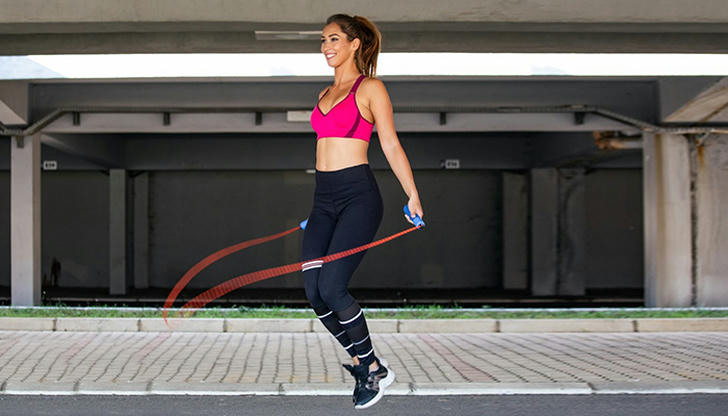How Jump Rope Can Help You Lose Weight
Did you know that jumping rope can help you burn calories faster than jogging because it takes less time yet burns more calories? Not only does it promote metabolism and engage muscles throughout the body, but it also doesn't require an outdoor space or a treadmill. You can start jumping rope on any small open space, or even at home.
How many calories burn in jumping rope?

An adult weighing 65 kg jogging at a speed of 7 km/h for 20 minutes consumes approximately 136.5 kcal.
Rapid jumping rope at a rate of 150 jumps per minute burns about 16 kcal per minute, resulting in burning about 160 kcal in 10 minutes.
Moderate-speed jumping rope, at a rate of 70 to 80 jumps per minute, burns approximately 10 kcal per minute, which burns about 100 kcal in 10 minutes.
The final calculated results are: • 10 minutes of rapid jumping rope ≈ 23 minutes of jogging • 10 minutes of moderate-speed jumping rope ≈ 15 minutes of jogging
Additionally, the calories burned in 3 minutes of jumping rope are equivalent to: • 10 minutes of brisk walking • 7 minutes of cycling • 5 minutes of playing tennis
How much weight can 30-day jump rope lose?

After reviewing several accounts shared online by individuals who have undertaken the 30-day jump rope challenge, we've identified some key facts:
• A woman who jumped 1000 times per day lost 3 kg and reduced her waist circumference by 5 cm over 30 days.
• A man named Jim challenged himself to jump rope for 10 weeks, starting with 2 minutes and gradually increasing to 10 minutes, and eventually being able to complete 30 minutes. After 5 weeks, he lost 1.8 kg. By the 10th week, he had cumulatively lost 5kg, and his abdominal muscles started to show definition, with even his pectoral and arm muscles becoming more visible.
• Another man, weighing 82 kg, lost 3.5 kg after a month of jumping rope, increasing his endurance from 1000 jumps at the start to 3000 jumps by the end.
Everyone's lifestyle, diet, and exercise background vary, so the weight loss effects of jump rope training differ from person to person. However, it appears that committing to a 30-day jump rope challenge can result in a weight loss of approximately 1.5 to 3 kg, along with improved cardiorespiratory endurance, increased muscle strength, and an overall better mood.
Why is the Calorie-Burning Efficiency of Jump Rope So High?

Many people underestimate the power of jumping. This seemingly simple act of jumping involves the whole body's muscles to overcome gravity and perform a stationary leap, which can exercise many large muscle groups throughout the body, especially the strength and endurance of the leg muscles.
This means that in a very short period, your body needs to efficiently utilize oxygen, which requires strong ventilation and gas exchange functions of the lungs, a strong contracting force and blood-pumping function of the heart, and high transport efficiency of the cardiovascular system.
Additionally, jump rope often reaches a high level of intensity in a short amount of time. You can try jumping rope continuously for 1 minute and repeat it for 3 sets, and you will immediately feel your heart rate soar and become breathless, which is almost like a form of High-Intensity Interval Training (HIIT). Therefore, jump rope is a very efficient way to lose weight for those who have limited time.
Precautions for Jumping Rope

As a beginner, it's essential not to set your goals too high for yourself. If you skip the warm-up in an attempt to lose weight quickly or push yourself to achieve targets beyond your physical endurance, you risk getting injured. Injuries can dampen your motivation and, most importantly, prevent you from continuing your weight loss plan. Therefore, the most critical aspect of jump rope training is to avoid injuries.
• Before jumping rope, warm up for at least 10 minutes.
• Wear shoes with cushioning.
• Start by gradually increasing the duration of your jump rope sessions, beginning with 5 minutes a day.
• During your jump rope workout, take a 30 second rest every minute to allow your body to recover. Or rest 10 seconds every 30 seconds.
• Drink electrolyte water before and after exercise.
• Avoid hard surfaces like asphalt and concrete, and opt for a rubber mat or a softer surface to lessen the impact on your joints.
• Stretch or massage your calves, thighs, and buttocks after your workout to aid in recovery and prevent muscle soreness.
• Soaking your feet in warm water before bed can help relax your foot muscles.
• Don’t jump too high. Lift your feet off the ground enough to allow the rope to pass underneath.
• Keep your elbows close to your body and use your wrists and forearms to turn the rope.
• After your feet touch the ground, slightly bend your knees to reduce stress on your joints.
